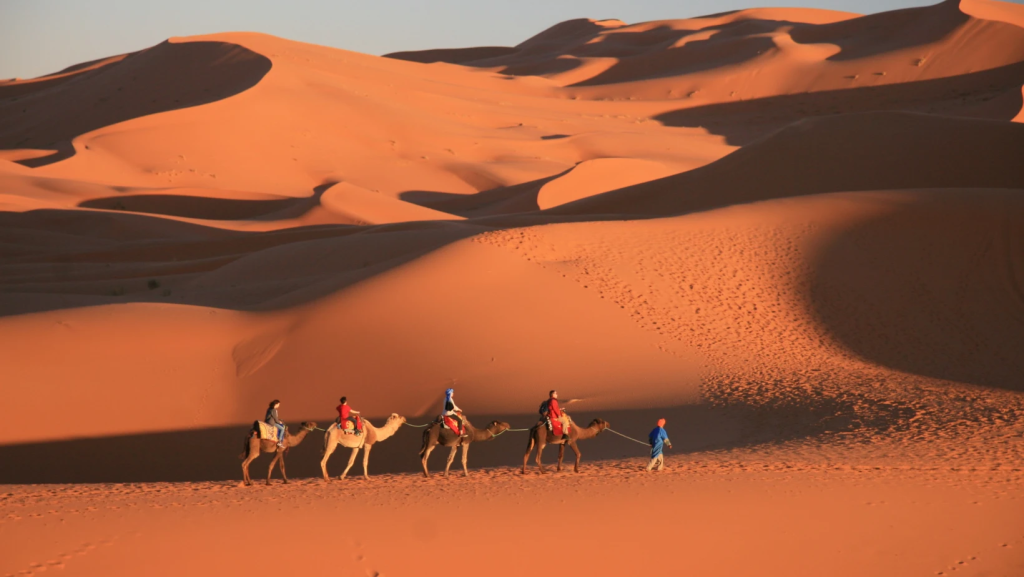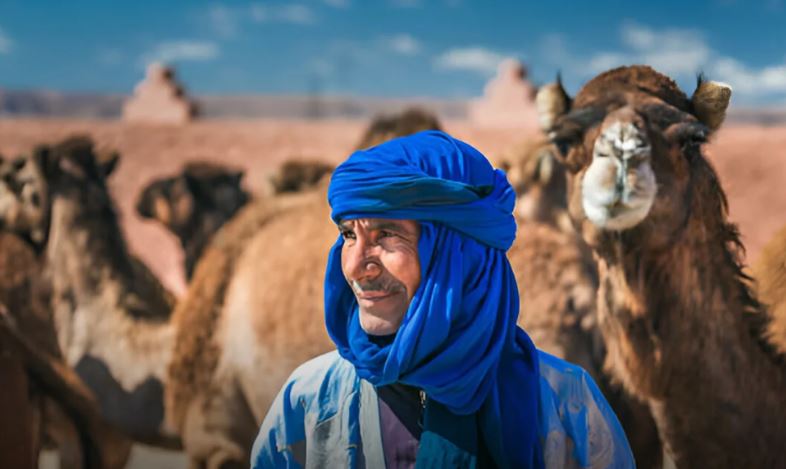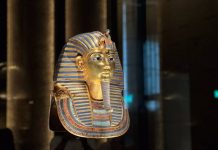Rabat – The Guelmim-Oued Noun region is an often-overlooked destination that offers visitors a perfect blend of natural beauty, tranquility, ancient traditions, and warm hospitality.
Located in the northern part of Morocco’s southern provinces, the region is ideal for those drawn to the golden dunes of the desert, picturesque beaches, and a glimpse into the timeless lifestyle of the nomadic people.
The region’s 240-kilometer coastline stretches from Mirleft in Sidi Ifni to Oued El Waer in Tan-Tan, offering long, sandy beaches that attract both locals and tourists.
A Beauty Like No Other
Beaches like Legzira in Sidi Ifni are famous for their dramatic landscapes, with high cliffs and natural rock arches carved by the Atlantic waters over the years. In 2016, The Huffington Post ranked Legzira as the 29th best beach in the world. While some of the arches have fallen, the remaining ones continue to draw visitors, especially during sunset, when the rocks glow a deep red.
The beaches of Sidi Ifni are perfect for swimming, sunbathing, or water sports like windsurfing and kitesurfing. They are also a photographer’s paradise and a haven for hikers.

The calm, crystal-clear waters and peaceful ambiance make these beaches an ideal, hidden getaway for those seeking tranquility by the sea.
El Ouatia, the coastal extension of the town of Tan-tan, also offers a relaxed atmosphere with expansive sandy shores. Known for its fishing and maritime activities, El Ouatia is another great spot for swimming and sunbathing, as well as fishing and exploring local markets.
Where the sea meets the desert
Another popular destination in the region is Tarfaya, a coastal town where the desert meets the Atlantic Ocean. It offers the unique opportunity to witness the fiery desert and the cool, salty sea breeze.
Guelmim-Oued Noun is home to some of Morocco’s most breathtaking desert landscapes. The vast Sahara Desert stretches across much of the region and it offers travelers a chance to experience a serene environment.
The desert landscapes are the region’s biggest attractions, with the vast stretches of golden sand dunes, rocky plateaus, and peaceful oases.
Must-visit oases include Tighmert and Asrir, located just south of Guelmim. They offer a glimpse into the tranquil beauty of the Sahara, with palm groves and traditional villages scattered across the desert floor.

These oases stretch across an area of about 100 hectares, hosting more than 143,000 date palms. Throughout history, the oases of southern Morocco have acted as a natural ecological belt on the edge of the desert.
Visitors can take camel rides through the dunes, spend nights under the star-filled sky, and experience the calm and solitude that only the desert can offer. They can also explore the local culture and enjoy a peaceful walk through the palm groves.
The region’s deserts and oases are ideal for eco-tourism and offer a perfect escape for those looking to experience Morocco’s wonders and connect with nature.
Nomadic life
Guelmim-Oued Noun covers an area of over 46,100 kilometers and has a population of more than 448,000.
It hosts 21% of Morocco’s nomadic population, making it the second most significant region after Draa-Tafilalet (60.8%). The town of Assa-Zag accounts for 13.8% of the national nomadic population, while Guelmim is listed as a province with a medium concentration of nomads (2–6%).
Nomads in the region have lived in harmony with the desert for centuries and maintained a deep connection to nature. Nomadic tribes mainly depend on raising animals such as goats and camels and move often to find water for their animals. These animals are valuable for their milk, meat, and sometimes wool.
Nomadic tribes are constantly on the move in search of water for their animals, and their homes, tents made from camel wool or goat hair, can be quickly packed and transported. These tents provide shelter from both the scorching sun and the cold desert nights.

Despite the several challenges they face, like harsh desert environments and limited access to water, many have adapted to their environment with a strong sense of resilience to maintain traditions passed down through generations.
Traditional cuisine
The region’s cuisine reflects its rich heritage, which is a melting pot of cultures that are deeply rooted in the unique traditions and lifestyle of southern Morocco. Local cuisine often features ingredients that are locally sourced and carefully prepared to adapt to the arid climate and the nomadic culture of the area.
Staple ingredients like barley, camel milk, as well as goat and camel meat are central to the local diet. Dishes such as beleghman, a mixture of roasted barley flour (dgig lmegli) combined with butter, milk, or ghee, are popular for their energy-rich properties.
Similarly, zrig, a refreshing drink made from yogurt, water, and sugar or milk mixed with roasted corn flour, is another nourishing yet simple drink.
Meat, particularly camel and goat, is often grilled over wood fires to produce rich, smoky flavors that are emblematic of the region. Traditional bread, baked over rocks or in handmade ovens, is another essential accompaniment to meals.
No meal is complete without Sahrawi tea, a prominent feature of local cuisine. It is prepared on coal with water, green tea, sugar, and gum arabic. Served both on a daily basis and on special occasions, Sahrawi tea represents community bonding, as well as the warmth and generosity of the people.

The hospitality in Guelmim-Oued Noun is legendary, and visitors often find themselves invited into local homes to share a cup of tea or a meal. Sharing food and stories around a warm fire and with a delicious cup of sea is an essential part of the region’s social life.
Music, dance, and traditional arts
Hassaniya is the primary language spoken in the region. In addition to being the mother tongue of the population living in the Sahara and Mauritanian, the dialect is more geographically dominant than it is thought to be.
It is spoken over a wider geographical area, including West Africa. It is spoken in parts of Niger and Mali, particularly by Sahrawi communities in the areas around Timbuktu, Kidal, and Gao in Mali, and parts of northern Niger.
Hassani literature, especially poetry, is a vital expression of Sahrawi culture. Through poetry, the people pass on their knowledge, values, and stories, with the aim of preserving the essence of their heritage.
Sahrawi music and dance are also an integral part of local culture, with performances often accompanied by traditional instruments. This artistic expression is an embodiment of the Sahrawi sensibility, intellect, courage, and the deep belief in beauty and the ability to create and inspire.

The music is known for its rhythmic patterns and emotional depth. It blends African, Berber, and Arabic influences and it is often performed at social gatherings, celebrations, and cultural festivals.
The dance is lively and rhythmic, and it is often performed in circles or lines. It involves fast movements and footwork, with dancers clapping their hands and stomping their feet to the rhythm of the music.
People in the region aso have unique traditional clothing, like Melhfa for women and Draa for men, that provides protection from the harsh desert sun. The Melhfa is a long piece of fabric, often colorful, that is wrapped around the body and head. The Draa, a robe worn by men, is typically paired with a head covering for additional sun protection.
Local women also wear beautiful jewelry, including bracelets, necklaces, and hairpieces, often made of silver. Beads, often in bright colors, are woven into necklaces, bracelets, and earrings, and stones like coral and amber are sometimes used to decorate jewelry.
Cultural festivals, such as the Moussem of Tan-Tan, also known as Amougar, celebrate the heritage of the region with music, dance, and displays of traditional clothing and jewelry. Recognized by UNESCO, this festival brings together tribes from across the Sahara for camel races, traditional music, and dancing.
Visitors can explore the unique crafts and artistry of the local communities, including handmade jewelry, intricate weaving, and leatherwork.
Each year, the Moussem of Tan-Tan hosts a different country as the guest of honor. The guest country sends a delegation to present its own culture, which creates an exchange of traditions and ideas.
Another significant cultural event is Guelmim Festival, where locals celebrate their heritage with music, dance, and traditional arts.
Handicrafts play an important role in the local economy, with artisans creating woven rugs, leather goods, and jewelry using time-honored techniques. These handmade items, which make perfect souvenirs, are displayed at festivals and show the region’s traditional craftsmanship.
BY: The Times Union







